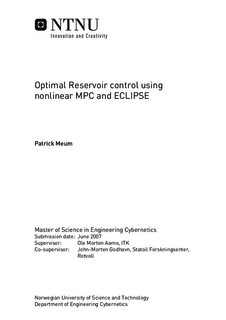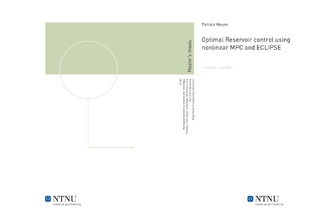| dc.description.abstract | Recent years advances within well deployment and instrumentation technology offers huge potentials for increased oil recovery from reservoir production. Wells can now be equipped with controllable valves at reservoir depth, which may possibly alter the production profitability of the field completely, if the devices are used in an intelligent manner. This thesis investigates this potential by using model predictive control to maximize reservoir production performance and total oil production. The report describes an algorithm for nonlinear model predictive control, using a single shooting, multistep, quasi-Newton method, and implements it on an existing industrial MPC platform - Statoil's in-house MPC tool SEPTIC. The method is an iterative method, solving a series of quadratic problems analogous to sequential quadratic programming, to find the optimal control settings. An interface between SEPTIC and a commercial reservoir simulator, ECLIPSE, is developed for process modelling and predictions. ECLIPSE provides highly realistic and detailed reservoir behaviour and is used by SEPTIC to obtain numerical gradients for optimization. The method is applied to two reservoir examples, Case 1 and Case 2, and develops optimal control strategies for each of these. The two examples have conceptually different model structures. Case 1 is a simple introduction model. Case 2 is a benchmark model previously used in Yeten, Durlofsky and Aziz (2002) and models a North Sea type channelized reservoir. It is described by a set of different realizations, to capture a notion of model uncertainty. The report addresses each of the available realizations and shows how the value of an optimal production strategy can vary for equally probable realizations. Improvements in reservoir production performance using the model predictive control method are shown for all cases, compared to basic controlled references cases. For the benchmark example improvements range up to as much as 68% increase in one realization, and 30% on average for all realizations. This is an increase from the results previously published for the benchmark, with a 3% average. However, the level of improvement shows significant variation, and is only marginal for example Case 1. A thorough field analysis should therefore be performed before deciding to take the extra cost of well equipment and optimal control. | nb_NO |

